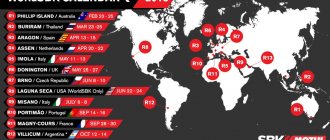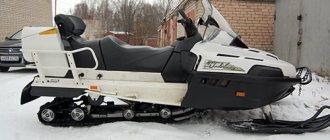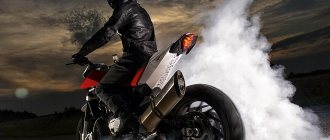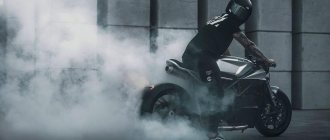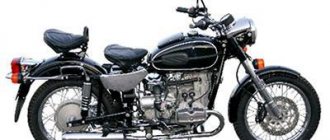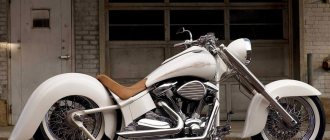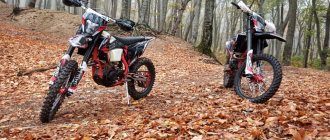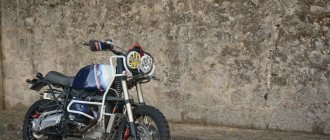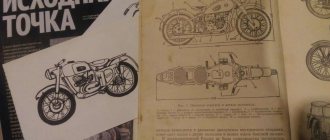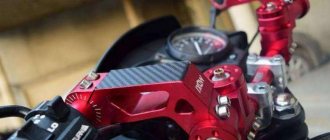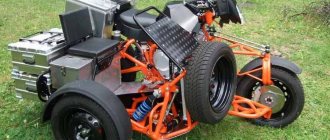WSBK: All about World Superbike 2022 - part 3 - Innovations in technical regulations
There are many changes in technical regulations. And changes, and additions, and innovations. Some of them are belt-tightening, but others are tightening the screws: by 2022, Dorna Sports wants to bring both the MotoGP and World Superbike world championships to some kind of common standard in the relationship between teams, manufacturers and the organizer.
Full review:
One of the basis of World Superbike for decades was the clause stating that classes are based on the division of mass-produced equipment based on the principle of engine size
.
In 2022, this clause of the regulations was supplemented with the addition of “ and a sufficient level of technical freedom
.” This legitimized the fact that Dorna and FIM now independently determine the volumes and types of engines that can be equated to the same class. In WorldSSP 300, a similar exception is made for the Honda factory, which will field its CBR500R against 300-390 cc motorcycles from KTM, Yamaha and Kawasaki. As for the WorldSSP 300, we don't know for sure (until the races have started) whether any of the smaller sportbikes have an advantage or not. Honda felt that the CBR300R would not be competitive enough against the KTM RC390, but Yamaha and Kawasaki are confident that the R3 and Ninja 300R will be. The FIM decided to agree. Similar caveats apply to all classes, if you look for them.
All Superbike motorcycles must have a dry weight of at least 168 kg
. There are no longer differences in engine type relative to minimum weight. Therefore, for V2 up to 1200 cc. There is an official requirement for the use of so-called “air restrictors” - plugs in air intakes of a certain diameter, which reduce the flow of air into the manifold, thus ensuring “balance” in power with in-line engines.
No matter how much Ducati struggles with this “balancing force” amendment, it cannot be canceled. Without a restrictor, the factory Panigales can actually gain an advantage, according to the FIM. That's why Ducati has finally decided, after 10 years of struggle, to make radical changes and develop a V4 superbike that could be launched as early as 2022. More on this: Ducati confirms Superbike V4 coming by 2018
.
All amendments that have been introduced to the technical regulations of World Superbike since 2014 were aimed at gradually reducing the costs of teams to participate - to reduce the cost of motorcycles, first of all, and their maintenance. And, on the one hand, all movements are in the right direction. Even Ducati understood this: the main problem of the Italian company has always been the high cost of preparing and tuning engines - first 999R, then 1098R, and now 1199R. Year after year, fewer and fewer private teams could afford to work with Borgo Panigale, and they regularly left for competitors.
Since 2016, WSBK has had a rule of unification of ECU and control software for all teams using motorcycles of the same brand. According to the regulations, the manufacturer must provide 50 sets (“Superbike Kit System”), consisting of a control unit, control panel, telemetry collection system (datalogger), inertial platform, as well as working sensors, software and support programs - all included in the kit should not be more than €8000. When updating the software of one participant, the manufacturer must upgrade all of them. Thus, equality within the same brand - no matter whether it is a factory team or a private one - is respected. This year there are no changes in this point. The plan to move the entire Superbike to a single ECU system, like in MotoGP, is still active and under discussion, but due to significant differences in the underlying platforms, it is not yet technically possible.
As for Supersport, in 2022 the rules for the use of engine control units will not change: for now you can use any, as long as the electronics kit does not cost more than €2,500. But already in 2022, a strict requirement will be introduced: all motorcycles in the 600 cc category will have to use only basic factory ECUs, like on street motorcycles.
Another additional restriction has been introduced in terms of braking systems. From 2022, the use of special “MotoGP specification” brake calipers containing iridium and beryllium is prohibited - now only pure aluminum
. Aluminum alloys with beryllium and iridium are used by some manufacturers of brake systems, in particular Brembo: these metals have the highest modulus of elasticity (beryllium - 300 GPa, iridium - 538 GPa), which ensures unsurpassed responsiveness and precision of the braking mechanisms even when the brake discs are heated above +700 degrees. However, such calipers cost incredible amounts of money (more than €5,400 per set): not all World Superbike stables can afford such expenses. To correct the imbalance, high-tech brakes were simply banned, following ceramic and carbon discs, as well as other prototype designs.
Further, the FIM technical regulations for World Superbike now allow the official use of Race ABS systems if they were originally developed by the manufacturer for that model and are included in the basic kit of the production model.
Changes in the rules for the use of suspensions await the Supersport class: the price limit for 1 set of tuning for a fork is €2200, for a shock absorber - €2000. In all classes there is a new rule on the use of “smart” suspensions: previously, this technology was completely prohibited for use, but now, if electronically adjustable shock absorbers (such as Ohlins TTX MarkII) are used by the manufacturer when creating production motorcycles, they can be used in a superbike ! All systems must be homologated by the FIM at the same time as the motorcycles.
From 2022, the World Superbike paddock will introduce a strict limit on spare motorcycles in all classes. The rule of one (single) bike for a pilot appeared in 2015, and starting from 2017 it will become stricter: according to the new amendment, there should not be a single assembled spare motorcycle either on the track or in the garage. In the SBK and SSP classes you cannot even store spare frames and swingarms in the team garage (if they exist, they must be placed in the technical room, in the paddock).
WSBK history: 30 years of victories and defeats
On the eve of the new WSBK season, we decided to recall the history of this racing series and tell in detail how it differs from all the others.
The Superbike World Championship is one of the largest and most successful sports competitions, the stages of which, in addition to Europe, take place in the USA and Australia, and before the beginning of the 2000s, some races took place in Japan. By the way, the FIM Superbike World Championship also came to Russia, because recently we have a European-level racing track.
Without exaggeration, the first Russian stage of WSBK 2012 can be called a landmark event for Russian sports
The history of World SBK began in the sixties, when slightly modified production motorcycles began to be raced in America. Until the end of the 80s, this race did not leave the New World and was a local event. Only after entering the world stage in 1988, the “Superbike” acquired its current form and became what we know it today.
Before the start of the first world stage of the 1988 Superbike Championship. Photo – mnz100.blogspot.com
In the first world championship in 1988, victory went to the Honda team, and with such an impressive lead over the European V-specs that the organizers had to change the technical regulations of the next races to equalize the chances.
According to the new rules, the working volume of two-cylinder engines was limited to 1000 cm 3, and for four-cylinder engines - 750 cm 3. Thanks to the new regulations and the painstaking work of its engineers, Ducati became the WSBK champion 14 times! It was from this moment that the engine volumes of Italian sportbikes began to increase, while Japanese manufacturers remained faithful to the traditions of the race for a long time.
Ducati 916 is a motorcycle that forever inscribed the name of the Italian company in the history of world sports. Photo – KAPPA
But don’t accuse the teams that lobbied for concessions for their motorcycles of cheating. The Italians at least drove factory cars, while Honda simply released the racing monster for free sale in a small series, which was enough for homologation. One of these now iconic homologation machines was the Honda RVF 750 RC45 sportbike.
The Honda RVF 750 motorcycle that won the first WSBK World Series in 1988. Photo – Knighter101
While in the land of the rising sun the standard in the form of in-line “fours” with a volume of 750cc ruled, the Italian “twos” sported 900 cc power units. The picture has not changed today - Japanese four-cylinder “liters” are running on par with 1200 cc twins.
A close relative of the RVF 750, now a collector's dream. Photo – Zombie Drive
However, we must also pay tribute to the Japanese, who built very successful sportbikes with V-shaped two-cylinder power units. In this regard, in 2003, the organizers canceled the relaxations and again equalized the engine volumes - regardless of the layout and number of pistons, the engine volume of all motorcycles of the participants should not exceed 1000 cubic centimeters.
The Honda VTR 1000 RC51 SP2 defeated Ducati with its own weapon – the V2 engine. Photo – Bazamoto.ru
Honda, Suzuki and Kawasaki again began to occupy the podiums one after another and the volume of “twos” was again allowed to increase. New regulations adopted in 2008 made it possible to “bore” engines up to 1200 cm 3 .
The abolition of concessions for V2 engines turned the World Championship into a race for Japanese manufacturers. Photo – WorldSBK
At various times, such iconic Italian manufacturers as Benelli, Bimota and MV Agusta took part in the race. In 2012, KTM also planned to take part in WSBK with its RC8R, but the Austrians’ big plans were not destined to come true - the motorcycle was discontinued and was not replaced with a new one. Today, the only European manufacturers represented in superbike are Aprilia, Ducati, BMW and Triumph.
KTM RC16 racing prototype. Photo – Dueroute
Superbike racing is very important for manufacturers, who spare no expense in supporting factory teams and improving motorcycles, because victory in competitions of this level will ensure increased popularity and increased sales. This is what makes WSBK so interesting, because the race is practically on production bikes that anyone can buy!
Of course, it can’t do without tuning - “blind” lightweight plastic, adjustable footrests, special clip-ons and radiators are allowed by the regulations, but only to an extent that does not radically affect the main design of the motorcycle. That is why on serial Ducati sportbikes in the R version you can see titanium connecting rods or the ability to adjust the height of the pendulum axis and the geometry of the steering column.
Ducati superbikes in R version have always stood out from other production motorcycles. Photo – Ducati
In addition to the “superbike” class, where there are more changes and modernization opportunities, there is also a 600 cc class – the so-called “supersport”. SSP has virtually no modification options at all; even pilots are required to use “civilian” tires. In addition, the WSBK hosts the Superstock 1000 FIM Cup and Superstock 600 European Championship, where production motorcycles with virtually no modifications compete.
Unlike the SBK, the Superstock class leaves even less room for modification and tuning. Photo – BMW Italia
The “superbike” race itself, as a rule, begins with training runs and qualifying, after which the competition itself takes place. Usually these are two races with a two-hour break between them, during which the pilots have the opportunity to think about tactics, and the mechanics have the opportunity to choose more suitable tires and “play” with the settings.
The winners, as you might guess, receive the maximum number of points - 25, all subsequent ones are less: starting from the second - 20 and so on until the 15th participant receives 1 point. Drivers who finish further than 15th place do not receive anything, and the leaders' points are summed up and based on their results at the end of the season, the name of the champion becomes clear.
Let's see who takes the gold in the 2022 season! Photo – Ducati
The current season, starting on February 24, promises to be extremely intriguing - the teams have already presented their motorcycles and participants, shared the results of the “winter” tests and are ready to hit the track in Australia’s Phillip Island.
Racing and car simulators There is probably not a child or teenager today who has never played car simulators on a computer. Of course, the opportunity to feel like you’re behind the wheel of the most modern and powerful car, to rush like a whirlwind through the most famous tracks and cities of the world, to be more skillful and faster than your friends in this competition - every self-respecting boy is ready to give half his life for this! And therefore, car simulators and racing have always been, are and will be one of the most popular genres of computer games. And their diversity will always pose difficult challenges to anyone who tries to classify these games in any way. But we will try to do it nonetheless. Types of car simulators All car driving simulators are usually divided into two large groups: - arcade car simulators, or simply racing (car racing). This is the most common and favorite type of such games. In racing, driving is simplified as much as possible and comes down to steering and speed control. For this, three buttons on the keyboard are enough; — realistic simulators, often intended not so much for entertainment, but for teaching driving and learning the rules of the road (educational 3D driving simulators); Of course, given the capabilities of modern digital devices, there are many options for games that are transitional options between these two types. A striking example of this is Need for Speed: Porsche Unleashed. In addition, the races themselves are most often implemented on several computers to play with live, real opponents. And special controls in the form of a steering wheel and gear shift knob give this game maximum realism. Add-ons Of course, no racing and car simulator would be so popular if they were limited to typical highway tracks and a simple set of cars. That's why they are simulators, to do something more in them than can be seen in reality. That is why in games you can choose and modify any track for yourself, use cars that have not yet been released for sale, compete on rally tracks, in cities, and even wage a real war on the road! But that's not all. Car simulators today are increasingly acquiring RPG elements, turning from a car driving simulator into a model of the life of a racing driver. Here you already have the opportunity to tune a car, earn money by winning street races and do your own PR. As a result, car simulators today are far from the primitive races that gamers were content with ten years ago. This is already an entire virtual life, uniting communities of living people who love speed and the inspiring feeling of victory. (racing games) via direct links and at high speed - it's fast, convenient and affordable!
All World Superbike (WSBK) Motorcycles - Technical Review
Ride faster, safer or what can we learn from studying the best SBK riders?
The rider's goal is to achieve a lower lean angle in the turn. This is noticeable because what trajectories are used and who is hanging and how. Everyone knows that the higher the bike, the more active you can be with the gas and brake, and to achieve this requires more body work. The tires work better if you don’t rub the working surface at the end of the first 10 laps out of 25. So when riders talk about “conserving the rubber,” a lot of the work is preserving traction by pushing yourself harder.
Motorcycle racing is not just about paper calculations. If everything were that simple, everyone would get perfect conditions and lap records and first places. But despite advanced technologies, a person is still at the head of the process, with his own characteristics of both motorcycle control and driving style. The following photos will show the best riders of the World Superbike during the apex and the author (an instructor at the Yamaha Champion Driving School - further text will be on his behalf) will comment on each one.
But first I’ll make a reservation. We cannot feel what exactly is happening to everyone in this turn, we don’t know whether he attacked at the entrance and is busy catching the clutch or entered slowly and is now unscrewing the handle. Having more information would allow us to give a more objective assessment in the description.
With that said, in my opinion, all the drivers are filmed in the moment, immediately after the end of braking, and smoothly accelerate, drawing a trajectory in a long turn. The riders are not yet at the exit, it is much more interesting to analyze the body position at that moment, where the majority will look for the best grip, where the ordinary ones are simply accelerating, and where the gifted ones will shine with skill.
And yes, this is important. At Yamaha Champions Riding School, we teach riders to continually adjust their body position throughout the track, which can make the difference between a good lap time and a lap record. Or the difference between winning on worn tires or sliding and losing ground. Or on the street, when, while taking a turn, at the last moment you notice dust/sand/pebbles on the chosen path. A lot depends on the body.
I've been analyzing the techniques of world racers for decades, as well as these guys. I have also worked directly with national and world class racers, some of whom were able to improve their performance after reviewing and adjusting their performance on the track.
Carlos Checa
You'll notice a similarity in the butt position of most riders, about half a foot off the saddle. But look how Carlos pinned his knee after entering the turn. This usually entails unloading the front, it would be a good idea to stick the knee out and load it. What I like about Cheka is that his head dives into the turn more than anyone else, if necessary - he can move his head to the center if his rear starts to float. This point is very important when setting up traction control: a rider who is able to compensate for lean angle better is less dependent on the operation of the traction control, and this in turn produces more power. In my opinion, traction control has made some riders lazier in the saddle, but the best ones are still the most active in the saddle.
Davide Giuliano
If Giuliano came to our school, we would have to work really hard on his upper body. The pelvis is well positioned, but the center of gravity (chest and shoulder level) remains too high on the bike, meaning he will need to lean more to match Cheka's lap times. Every time I say "more angle", I say "more risk". Giuliano takes more risks in the same radius. But his upper body position doesn't ruin everything - he continues to go fast. But for example, at the height of the season in a long, wet corner, he would risk even more. Riders with this riding style need more fine-tuning of their bike.
Eugene Laverty
I'm a big fan of Eugene's style with one caveat: I would talk to him about how he hangs on the handles. We would discuss how best to maintain balance in one place, taking into account the outside leg and inside foot. It would be nice if he moved his pelvis a couple of centimeters into the saddle, being better anchored to the bike, thereby reducing the pressure of his hands to achieve one goal: better feel in the front. After which, I would suggest that he not expose his head so radically, for a better exit from the turn. Again, without feeling the bike, I can only guess, but I like the way it looks in the saddle in this position. Look how deep Laverty and Cheka sit in the saddle - this is good because the wrist has good geometry and the gas tank does not put pressure on the chest.
Jakub Smrz
You can notice how Jakub moves slightly towards the gas tank, or rather his upper part (torso, head) compared to Laverty, Cheka (and in MotoGP, Stoner and Lorenzo for example). If Smrz came to visit us, first of all we would lower him from the gas tank about five centimeters, giving his chest more space. This way he could better control his center of gravity while in the saddle. The motorcycle, in turn, would turn easier, not at such an angle, and the tires would last longer. Changing his position in the saddle would make him less dependent on the settings. And finally: for riders who lean on the tank, it is more difficult to catch the front when entering a turn on the knee.
Leon Camier
I like. Camier is a tall guy and as an experiment I would like to sit him 3-4cm deeper in the saddle to see if he feels more comfortable with his head tucked in when exiting. Take a close look at his right wrist and see how smoothly it goes to the throttle. Riders who feel discomfort in right turns (Leonov) always need a similar exercise to lift their elbow away from their chest. If Camier had asked me for advice, I would have loosened his position a little and asked him to move more while riding.
SBK X: Superbike World Championship
Fingers aching from pain and the buttons on the keyboard creaking from wear that are responsible for controlling the motorcycle - that’s what SBK X Superbike World Championship
in “simulator” mode.
After trying a dozen racing arcade games, getting to know this game is truly surprising. But only if you really wanted to try something more realistic before - after all,
only those who are not afraid of the above side effects can master SBK
The trees on the sides lack leaves and three-dimensionality.
Non-arcade reality
SBK
is notable primarily for two things: first-class physics and a full package of purchased licenses. The controls turned out to be very realistic - absolutely everything is taken into account. If you have ever watched broadcasts of motorcycle competitions on TV and watched how two-wheeled monsters, together with the riders, roll to one side when turning, then know: the complex process of controlling a motorcycle using a standard computer gamepad (that is, a keyboard) will seem like absolute hell. You need to accurately calculate at what second you start braking in order to get into the next turn. It is necessary to clearly understand when acceleration will minimally damage the handling and stability of your motorcycle, and calculate the time of arrival at the service station so that it affects the final rating as little as possible.
Now it may seem to you that performing the duties from the above list is not such a difficult task. But only the very first turn, which will more than likely turn out to be unsuccessful, will dispel all amateurish doubts. SBK
, as before, keeps the hardcore bar at an unattainable height - very few people do this today.
Of course you can play in arcade mode, but then SBK X
will turn into a long and not the most entertaining race on a super expensive racing bike with lousy graphics and cardboard stands. As is the case with budget Formula 1 simulators, the most important thing is reliable physics. Very precise and positional control is aided by detailed motorcycle settings - there are several dozen of them, and, rest assured, each can significantly influence the outcome of the race. We think that there is no need to harp on what is the importance of correct tire selection, brake system adjustment and much more?
Now we are going to make candy out of this Yamaha!
Along with realistic physics and numerous settings for your iron horse, weather conditions, different track surfaces and everything around them take part in increasing the reliability factor. A little rain will quickly interfere with the balance of natural forces that influence the behavior of the motorcycle and will force you to be more attentive on the track. Least.
An expensive license is the second significant argument in favor of SBK
: all brands of advertisers, motorcycles, track names correspond to reality.
The championship itself was not very long in duration - just over a dozen races with all the necessary preliminary qualifications, and special emphasis is placed on online riding. There, as offline, you won’t be able to adapt to the playing style of one big artificial intelligence and take advantage of its weaknesses - there are so many people, so many management styles, and this must be taken into account.
“Want to ride a motorcycle with me, baby?”
***
SBK X Superbike World Championship
will be of interest primarily to those for whom complex and realistic controls will help them close their eyes to the noticeable shortcomings of the graphics and musical accompaniment (the soundtrack for this game was traditionally unconvincing and gray). This is a simulator in the best sense of the word. Fans of Need for Speed and Burnout have absolutely nothing to do here.
Pros:
realistic controls and physics;
a lot of settings for the motorcycle; interesting online mode; licensed motorcycles. Cons:
weak graphics; The story mode turned out to be quite short.
Write a comment Total comments: 11
